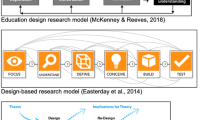Summary
The field of instructional technology is full of pragmatic instructional design models but short on descriptive models. The conceptual model we have presented classifies what we study or hear about in instructional design and technology courses into eight categories. This model does connects different content together, and also goes the next step in exploring how a practitioner’s lens affects his or her design. Any conceptual model constructed should be able to incorporate all the current knowledge as well as accommodate any developments that may occur in the future. To date, through discussion and comparison to other models, we have determined that our model is comprehensive. We recognize that very few descriptive models exist, and welcome the opportunity to discuss it and further develop it with practitioners and experts in the field. Give us your feedback and suggestions by sending an e-mail message to one of the authors (Stephanie Roberts,sroberts@hyperformer.com, Cynthia Conn,connister@aol.com, or Linda Lohr,linda.lohr@unco.edu).
Similar content being viewed by others
References
Creswell, J. W. (1998). Qualitative inquiry and research design: Choosing among five traditions. Thousand Oaks, CA: SAGE Publications.
Crotty, M. (1998). The foundations of social research: Meaning and perspective in the research process. London: SAGE Publications.
Dick, W. &Carey, L. (1996). The system design of instruction (4th ed.). Glenview, IL: Scott F. Foresman.
Foucault, D. (1969). The archaeology of knowledge. Pantheon Publishing, New York.
Hannafin, M. J., Hannafin, K. M., Land, S. M., & Oliver, K. (1997). Grounded practice and the design of constructivist learning environments.Educational Technology Research and Development, 45(3), 101–117.
Jonassen, D. H. (1991). Objectivism versus constructivism: Do we need a new philosophical paradigm?Educational Technology Research & Development, 39(3), 5–14.
Kuhn, T. S. (1974). The structure of scientific revolutions (2nd ed.). Chicago: University of Chicago Press.
Morrison, G. R., Ross, S. M., & Kemp, J. E. (2001). Designing effective instruction. New York, NY: John W. Wiley & Sons.
Mager, R. E. (1988). Making instruction work. Belmont, CA: Lake Publishing Company.
Ozmon, H., & Craver, S. (1992). Philosophical Foundations of Education (Fifth ed.). Englewood Cliffs: PrenticeHall, Inc.
Reigeluth, C. M. (1995). Instructionaldesign theories and models: A new paradigm of instructional theory (Vol 2). Hillsdale, NJ: Lawrence Erlbaum.
Rossett, A. (1999). First things fast: A handbook for performance analysis. San Francisco, CA: Jossey-Bass/ Pfeiffer.
Seels, B. B., & Richey, R. C. (1994). Instructional technology: The definition and domains of the field. Washington, DC: Association for Educational Communications and Technology.
Smith, P. L. & Ragan, T. J. (1999). Instructional Design (2nd ed.). Upper Saddle River, NJ: Prentice-Hall.
Stolovitch, H. D., & Keeps, E. J. (1999). What is human performance technology? In H.D.Stolovitch and E. J.Keeps (Eds.), Handbook of Human Performance Technology (2nd ed.) (pp. 2–23). San Francisco, CA: Jossey-Bass/Pfeiffer.
Author information
Authors and Affiliations
Rights and permissions
About this article
Cite this article
Roberts, S., Conn, C., Lohr, L. et al. Not another ID model. TECHTRENDS TECH TRENDS 47, 15–20 (2003). https://doi.org/10.1007/BF02763507
Issue Date:
DOI: https://doi.org/10.1007/BF02763507



